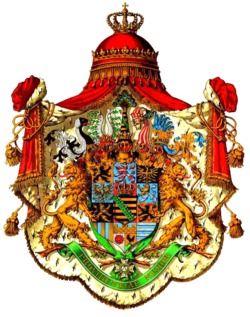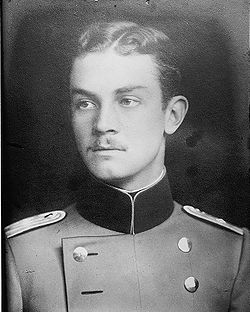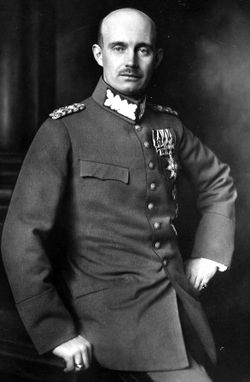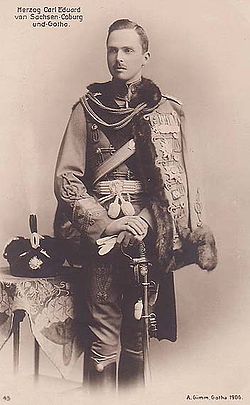Seznam německých panovníků podle data abdikace v roce 1918
Tento seznam zobrazuje všechny panovníky v rámci Německého císařství postupně podle toho kdy abdikovali během německé revoluce v roce 1918, která svrhla monarchii v Německu.
Média použitá na této stránce
Flag of the Germans(1866-1871)
Flag of the Germans(1866-1871)
Wappen des Großherzogtums Oldenburg im 2. Deutschen Kaiserreich
Wappen Deutsches Reich - Herzogtum Braunschweig (Grosses). Greater shield of the Dukes of Brunswick-Lüneburg (later Electors of Hanover and Kings of the United Kingdom). Quarterly of 12:
- 1:
 Duchy of Lüneburg (Or semée of hearts gules, a lion rampant azure armed and langued of the second. The coat of arms of Lüneburg consisted of a blue lion on a gold field, which was sprinkled with red hearts. It was derived from the coat of arms of Denmark: the mother of Otto I, 1st Duke of Brunswick-Lüneburg was Princess Helena of Denmark. (Source: https://www.wikipe.wiki/wiki/nl/Wapens_van_Brunswijk_en_Lueneburg)
Duchy of Lüneburg (Or semée of hearts gules, a lion rampant azure armed and langued of the second. The coat of arms of Lüneburg consisted of a blue lion on a gold field, which was sprinkled with red hearts. It was derived from the coat of arms of Denmark: the mother of Otto I, 1st Duke of Brunswick-Lüneburg was Princess Helena of Denmark. (Source: https://www.wikipe.wiki/wiki/nl/Wapens_van_Brunswijk_en_Lueneburg) - 2:
 Duchy of Brunswick/Braunschweig (Gules, two lions passant guardant in pale or); In 1235 Otto I was elevated to Duke of Brunswick and Lüneburg by the Emperor. He was the only son of w:William of Winchester, Lord of Lunenburg, born in Winchester, England, the fifth and youngest son of the deposed Duke Henry the Lion of Saxony and Bavaria by his wife Matilda, the eldest daughter of King Henry II of England. Otto's royal lineage was accentuated by the arms designed for Brunswick and Lüneburg. The coat of arms of Brunswick consisted of two golden leopards in a red field and was derived from the coat of arms of England because of the marriage of Henry the Lion to Mathilde of England. (Source: https://www.wikipe.wiki/wiki/nl/Wapens_van_Brunswijk_en_Lueneburg)
Duchy of Brunswick/Braunschweig (Gules, two lions passant guardant in pale or); In 1235 Otto I was elevated to Duke of Brunswick and Lüneburg by the Emperor. He was the only son of w:William of Winchester, Lord of Lunenburg, born in Winchester, England, the fifth and youngest son of the deposed Duke Henry the Lion of Saxony and Bavaria by his wife Matilda, the eldest daughter of King Henry II of England. Otto's royal lineage was accentuated by the arms designed for Brunswick and Lüneburg. The coat of arms of Brunswick consisted of two golden leopards in a red field and was derived from the coat of arms of England because of the marriage of Henry the Lion to Mathilde of England. (Source: https://www.wikipe.wiki/wiki/nl/Wapens_van_Brunswijk_en_Lueneburg) - 3:
 County of Eberstein/Everstein (Azure, a lion rampant argent armed and langued gules crowned or); w:de:Everstein (Adelsgeschlecht); In 1425 w:Otto IV, Duke of Brunswick-Lüneburg (d.1446) (son of w:Bernard I, Duke of Brunswick-Lüneburg) married the heiress Countess Elizabeth of Eberstein (c.1415-1468), which gave him the possession of the County of Eberstein in 1408. The dukes included the arms of Eberstein and Homburg in their coat of arms in 1482. Their descendants, the later Electors of Hanover and the Dukes of Brunswick, continued to do so. (Source: https://www.wikipe.wiki/wiki/nl/Wapens_van_Brunswijk_en_Lueneburg)
County of Eberstein/Everstein (Azure, a lion rampant argent armed and langued gules crowned or); w:de:Everstein (Adelsgeschlecht); In 1425 w:Otto IV, Duke of Brunswick-Lüneburg (d.1446) (son of w:Bernard I, Duke of Brunswick-Lüneburg) married the heiress Countess Elizabeth of Eberstein (c.1415-1468), which gave him the possession of the County of Eberstein in 1408. The dukes included the arms of Eberstein and Homburg in their coat of arms in 1482. Their descendants, the later Electors of Hanover and the Dukes of Brunswick, continued to do so. (Source: https://www.wikipe.wiki/wiki/nl/Wapens_van_Brunswijk_en_Lueneburg) - 4:
lordship of Homburg; in 1409 w:Bernard I, Duke of Brunswick-Lüneburg (1358/64-1434) ("Middle House of Lüneburg") bought the lordship of Homburg, whose lords had died out in 1408. (Source: https://www.wikipe.wiki/wiki/nl/Wapens_van_Brunswijk_en_Lueneburg)
- 5:
 county of Diepholz. In 1585 the lords of Diepholz died out with Frederick II. The area later named a county fell to Duke William of Brunswick-Celle, (w:William the Younger, Duke of Brunswick-Lüneburg (d.1592)) the founder of the newer branch of Lüneburg. His brother Hendrik van Brunswijk-Dannenberg (w:Henry, Duke of Brunswick-Dannenberg (1533-1598))) was the founder of the newer branch Brunswijk. They both included Diepholz's coat of arms in their coat of arms.
county of Diepholz. In 1585 the lords of Diepholz died out with Frederick II. The area later named a county fell to Duke William of Brunswick-Celle, (w:William the Younger, Duke of Brunswick-Lüneburg (d.1592)) the founder of the newer branch of Lüneburg. His brother Hendrik van Brunswijk-Dannenberg (w:Henry, Duke of Brunswick-Dannenberg (1533-1598))) was the founder of the newer branch Brunswijk. They both included Diepholz's coat of arms in their coat of arms. - 6:
county of Lauterberg;
- 7:

- 7a:
 w:County of Hoya; w:de:Grafschaft Hoya; In 1582 the house of Hoya died out with Count Otto VIII. Half of the county of Hoya belonged to Duke Wilhelm of Brunswick-Celle (?w:William the Younger, Duke of Brunswick-Lüneburg (1535-1592)) from the middle branch of Lüneburg, the other half to Duke Julius of Brunswick-Wolfenbüttel from the middle branch of Brunswick. The coats of arms of the County of Hoya and the associated lordships of Alt-Bruchhausen and Neu-Bruchhauden were added to the arms of both branches. Brunswijk-Wolfenbüttel carried this coat of arms until 1596 and Brunswijk-Harburg until 1624. (Source: https://www.wikipe.wiki/wiki/nl/Wapens_van_Brunswijk_en_Lueneburg)
w:County of Hoya; w:de:Grafschaft Hoya; In 1582 the house of Hoya died out with Count Otto VIII. Half of the county of Hoya belonged to Duke Wilhelm of Brunswick-Celle (?w:William the Younger, Duke of Brunswick-Lüneburg (1535-1592)) from the middle branch of Lüneburg, the other half to Duke Julius of Brunswick-Wolfenbüttel from the middle branch of Brunswick. The coats of arms of the County of Hoya and the associated lordships of Alt-Bruchhausen and Neu-Bruchhauden were added to the arms of both branches. Brunswijk-Wolfenbüttel carried this coat of arms until 1596 and Brunswijk-Harburg until 1624. (Source: https://www.wikipe.wiki/wiki/nl/Wapens_van_Brunswijk_en_Lueneburg) - 7b1:
lordship of Neu-Bruchhausen; Wappen der Grafschaft Neubruchhausen
- 7b2:
; lordship of Alt-Bruchhausen;
- 7a:
- 8:
 county of Diepholz
county of Diepholz - 9:
county of Hohnstein; In 1593, the Klettenberg branch of the Counts of Hohnstein died out. The Counts of Stolberg inherited the county, but Brunswijk also claimed the county as liege lord. In 1596, the Dukes of Brunswick-Wolfenbüttel took up the arms in their coat of arms. Eventually the county was divided between Brunswijk and Stolberg. (Source: https://www.wikipe.wiki/wiki/nl/Wapens_van_Brunswijk_en_Lueneburg)
- 10:
county of Regenstein;
- 11:
county of Klettenberg;
- 12:
county of Bankenburg. In 1599 the counts of Blankenburg died out with Count Johan Ernst. The county came to Brunswick-Wolfenbüttel as a vacant fief. The arms of the counts of Blankenburg were also added. After the death of Duke Hendrik Julius in 1613, the ranking was changed by his successor Frederik Ulrich. With this duke the middle house Brunswijk (in Wolfenbüttel) died out in 1634.(Source: https://www.wikipe.wiki/wiki/nl/Wapens_van_Brunswijk_en_Lueneburg)
Schwarzburg-Sondershausen.
Grand Duke Frederick II of Baden (1857–1928), wearing the Uniform of His Life Grenadiers (109th in the Royal Prussian Army)
Friedrich, Prince of Waldeck and Pyrmont
Coat of Arms of the Principality of Reuss Junior Line
knížectví Lippe.
Coat of arms of the Kingdom of Württemberg valid from 1817 to 1918.
The great coat of arms of the Kingdom of Saxony (Albertine line of the House of Wettin)
Fotografie des Erbprinzen Bernhard von Sachsen-Meiningen (1851-1928)
Greater Coat of Arms of the Duchy of Saxe-Meiningen. Art by Hugo Gerhard Ströhl, late 19th century or early 20th century.
Heinrich XXVII., Principality of Reuss Junior Line
Autor: Glasshouse with elements by Sodacan, Tom-L and katepanomegas, Licence: CC BY-SA 4.0
Coat of Arms of the Principality of Waldeck and Pyrmont
Autor: Glasshouse using elements by Sodacan, Licence: CC BY-SA 4.0
Coat of Arms of the Principality of Schaumburg-Lippe
Wappen Grossherzogtum Baden
Autor: ziegelbrenner, Licence: CC BY-SA 3.0
Map of German Reich 1871–1918
Frederick Augustus III of Saxony (1865-1932) in 1902.
Großes Wappen des Königreichs Bayern
Großherzog Friedrich August von Oldenburg
Coat of arms of the Grand Duchy of Saxe-Weimar-Eisenach
A photograph of Gunther Victor, last Prince of Schwarzburg, Germany
Ernst Lodewijk van Hessen
Greater coat of arms of Prussia used when part of the German Empire. Note the inclusion of the subcoats for Holstein and Schleswig (both in the second row), identifying this coat of arms as no earlier than 1867.
Heinrich XXIV. Reuß ältere Linie (* 1878; † 1927)
Greater coat of arms of the former Germany duchy of Saxe-Altenburg
(c) Bundesarchiv, Bild 146-2004-0096 / E. Bieber / CC-BY-SA 3.0















































































